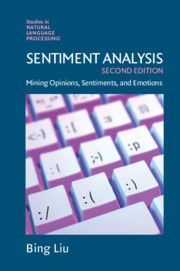Book contents
- Sentiment Analysis
- Studies in Natural Language Processing
- Sentiment Analysis
- Copyright page
- Contents
- Preface
- Acknowledgments
- 1 Introduction
- 2 The Problem of Sentiment Analysis
- 3 Document Sentiment Classification
- 4 Sentence Subjectivity and Sentiment Classification
- 5 Aspect Sentiment Classification
- 6 Aspect and Entity Extraction
- 7 Sentiment Lexicon Generation
- 8 Analysis of Comparative Opinions
- 9 Opinion Summarization and Search
- 10 Analysis of Debates and Comments
- 11 Mining Intent
- 12 Detecting Fake or Deceptive Opinions
- 13 Quality of Reviews
- 14 Conclusion
- Appendix
- Bibliography
- Index
10 - Analysis of Debates and Comments
Published online by Cambridge University Press: 23 September 2020
- Sentiment Analysis
- Studies in Natural Language Processing
- Sentiment Analysis
- Copyright page
- Contents
- Preface
- Acknowledgments
- 1 Introduction
- 2 The Problem of Sentiment Analysis
- 3 Document Sentiment Classification
- 4 Sentence Subjectivity and Sentiment Classification
- 5 Aspect Sentiment Classification
- 6 Aspect and Entity Extraction
- 7 Sentiment Lexicon Generation
- 8 Analysis of Comparative Opinions
- 9 Opinion Summarization and Search
- 10 Analysis of Debates and Comments
- 11 Mining Intent
- 12 Detecting Fake or Deceptive Opinions
- 13 Quality of Reviews
- 14 Conclusion
- Appendix
- Bibliography
- Index
Summary
Opinion documents come in many different forms. So far, we have implicitly assumed that individual documents are independent of each other or have no relationships. In this chapter, we move on to two forms of social media contexts that involve extensive interactions of their participants and are also full of expressions of sentiments and opinions: debates/discussions and comments. However, the key characteristic of the documents in such media forms is that they are not independent of each other, in contrast to stand-alone documents such as reviews and blog posts. The interactive exchanges and discussions among participants make these media forms much richer targets for analysis. Such interactions can be seen as relationships or links both among participants and among posts. Thus, we can not only perform sentiment analysis, as discussed in previous chapters, but also carry out other types of analyses that are characteristic of interactions – for example, grouping people into camps, discovering contentious issues of debates, mining agreement and disagreement expressions, discovering pairwise arguing nature, and so on. Because debates are exchanges of arguments and reasoning among participants who may be engaged in some kind of deliberation to achieve a common goal, it is interesting to study whether each participant in online debate forums gives reasoned arguments with justifiable claims via constructive debates, or whether a participant just exhibits dogmatism and egotistical clashes of ideologies. These tasks are important for many fields of social science, such as political science and communications. Central to these tasks are the sentiments of agreement and disagreement, which are instrumental to these analyses. These additional types of analyses are the focus of this chapter.
Information
- Type
- Chapter
- Information
- Sentiment AnalysisMining Opinions, Sentiments, and Emotions, pp. 273 - 293Publisher: Cambridge University PressPrint publication year: 2020
